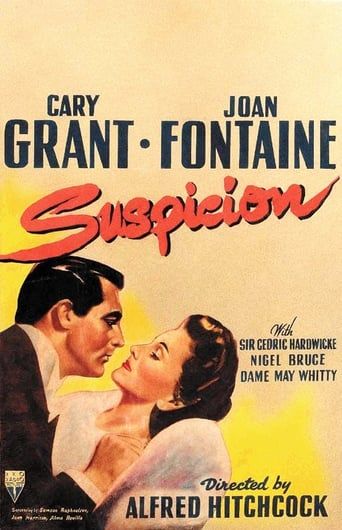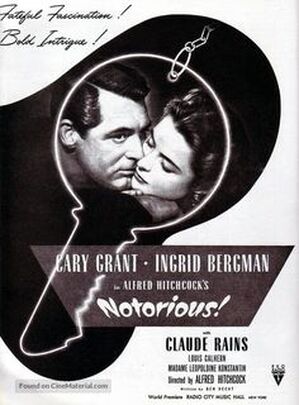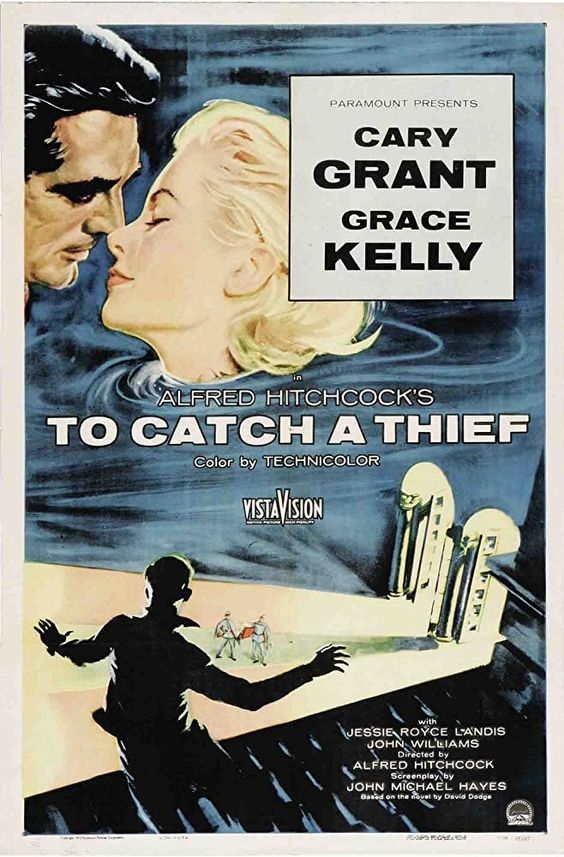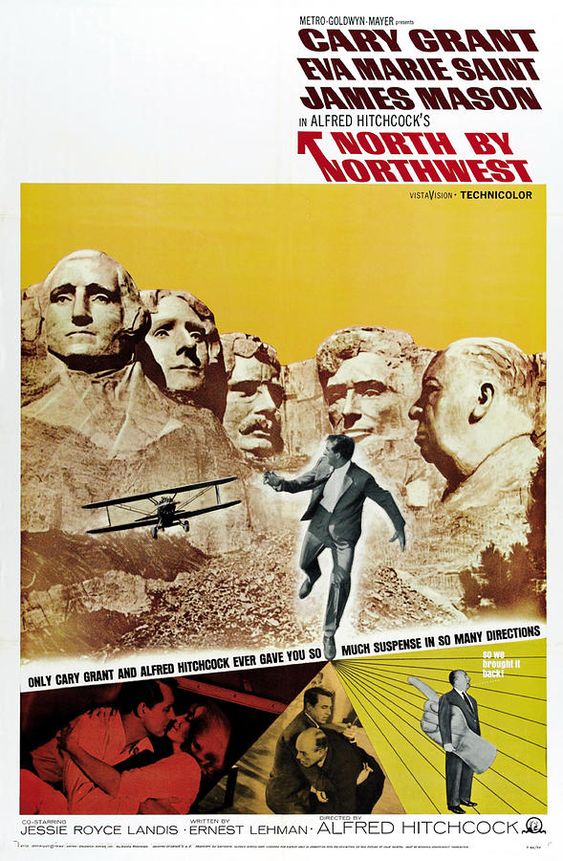Alfred Hitchcock & Cary Grant Together: Twisted image
I've been working my way through the films of Alfred Hitchcock in preparation for an up-coming Top 10 List. Usually, I watch the films in chronological order to better gage the growth of the artist throughout their career, as well as the normal ups & downs in the quality of their films. With Hitch, however, I've been bouncing around, watching several of the David O. Selznick period ('40-'47, Rebecca, Shadow of a Doubt, Saboteur), while also dropping in a couple of the later masterpieces (Rear Window, To Catch a Thief, Psycho & North By Northwest). This randomness allowed me to watch all 4 of the collaborations between Alfred Hitchcock & Cary Grant in a short amount of time. Seeing Suspicion ('41), Notorious ('46), To Catch a Thief ('55) & North By Northwest ('59) together, illustrated how Hitchcock manipulated Grant's image to his own devises, while giving the actor rare opportunities to stretch as an actor & deliver several of the best performances of his career.
Grant's career before Suspicion was filled with light screwball comedy roles in classics like Bringing Up Baby (’38), The Philadelphia Story (’40) & His Girl Friday (’40). He usually played a fast talking slickster who could always manipulate everyone around him, making sure he ended up with the girl of his choice. In Suspicion, however, he talks fast, but he’s clearly an exploiter & uses the people around him for purely selfish reasons. He is dark & mysterious & while he is still able to sweep a woman (Joan Fontaine) off her feet, he cannot maintain the charm after they’re married. When Fontaine starts to suspect him of murder things really get dark as Hitchcock uses a purely subjective point of view to reinforce Grant’s Johnnie Aysgarth as cold & calculating.
Grant's career before Suspicion was filled with light screwball comedy roles in classics like Bringing Up Baby (’38), The Philadelphia Story (’40) & His Girl Friday (’40). He usually played a fast talking slickster who could always manipulate everyone around him, making sure he ended up with the girl of his choice. In Suspicion, however, he talks fast, but he’s clearly an exploiter & uses the people around him for purely selfish reasons. He is dark & mysterious & while he is still able to sweep a woman (Joan Fontaine) off her feet, he cannot maintain the charm after they’re married. When Fontaine starts to suspect him of murder things really get dark as Hitchcock uses a purely subjective point of view to reinforce Grant’s Johnnie Aysgarth as cold & calculating.
In Notorious Hitchcock signals in his first shot of Grant that this will be a different type of leading man. He shoots him with his back to the camera, in complete shadow, as a dark shadow dropped into a party scene. Once again he manipulates a woman to get what he wants; this time getting Ingrid Bergman to infiltrate a ring of Nazi’s in post WWII Rio. When he seduces her first, he is a charming as a Grant character would be expected to be, but there is always a subtle darkness & cool detachment. Once he has her on the hook, so to speak, he turns cruel as he denies her feelings for him & essentially prostitutes her in the name of country. Once again, Hitchcock flips the light & charming Grant personae to put viewers on their heels, not allowing them to expect the traditional conclusion & heightening the suspense & intrigue of the story.
To Catch a Thief is the transition film. While not reclaiming the Grant mystique, it does at least portray him as a recovered scoundrel, albeit one perfectly capable of bad actions. Playing a reformed master cat burglar (and resistance hero), Grant has the look of someone capable of mischief, but his actions constantly belie his former life. Is it a trick that Hitchcock is once again playing on the viewer, expecting a certain type of Grant character or is it a reinforcement? That’s the genius of Hitchcock using the same actors in multiple films; he is always looking for ways to alter expectations within a movie by relying on things outside of it. In To Catch a Thief Hitch waits until the climax to reveal his true character, leaving the viewer to constantly guess…a sure fire way to heighten suspense & undermine expectations.
Finally, there is North By Northwest. Grant’s Roger Thornhill is defined as a shallow stuffed shirt in the very first scene, dictating false good wishes to a discarded girlfriend, while he rushes to catch a cab. He looks good; he sounds good, but he is clearly not interested in anyone but himself. When he is dragged into an espionage plot he is nonchalant & flip, worried more about his theater tickets than his personal well-being. What transpires over the remainder of the film, however, is the transformation of the Grant personae (and Thornhill) into a deeply caring person, willing to sacrifice himself for someone else. In fact, the devilish Hitchcock even includes a tweak of the normal Grant personae when he has a female hospital patient first scream “Stop!” as Grant enters her room through a window, then getting a better look at him purrs “stop,” in an effort to get him into bed. In North By Northwest, however, he is neither flip, nor shallow. He is a hero. But in the world of Hitchcock, set up by the three previous films, it is a revelation that repeatedly plays against expectations & has the restorative power to put a wonderful capstone on their working relationship.
It has been often told that if the icy blondes Hitchcock preferred as his heroines were his fetishized sexual fantasy come to life, then Cary Grant was the man Hitch wished he could be. Physically, the differences were obvious, but in manipulating Grant’s personae in these 4 films, Hitch helped give the actor more depth & nuance. There was clearly a dark side to Hitchcock, so why not have it manifest itself in his films in the person of a tall & handsome leading man? Of course, for Hitchcock, the film was always the thing, so his manipulation had as much to do with plot & suspense as with tweaking the personae of his leading man, but it’s a wonderful thing that he decided to put his darkness out there is such a beautiful package.
To Catch a Thief is the transition film. While not reclaiming the Grant mystique, it does at least portray him as a recovered scoundrel, albeit one perfectly capable of bad actions. Playing a reformed master cat burglar (and resistance hero), Grant has the look of someone capable of mischief, but his actions constantly belie his former life. Is it a trick that Hitchcock is once again playing on the viewer, expecting a certain type of Grant character or is it a reinforcement? That’s the genius of Hitchcock using the same actors in multiple films; he is always looking for ways to alter expectations within a movie by relying on things outside of it. In To Catch a Thief Hitch waits until the climax to reveal his true character, leaving the viewer to constantly guess…a sure fire way to heighten suspense & undermine expectations.
Finally, there is North By Northwest. Grant’s Roger Thornhill is defined as a shallow stuffed shirt in the very first scene, dictating false good wishes to a discarded girlfriend, while he rushes to catch a cab. He looks good; he sounds good, but he is clearly not interested in anyone but himself. When he is dragged into an espionage plot he is nonchalant & flip, worried more about his theater tickets than his personal well-being. What transpires over the remainder of the film, however, is the transformation of the Grant personae (and Thornhill) into a deeply caring person, willing to sacrifice himself for someone else. In fact, the devilish Hitchcock even includes a tweak of the normal Grant personae when he has a female hospital patient first scream “Stop!” as Grant enters her room through a window, then getting a better look at him purrs “stop,” in an effort to get him into bed. In North By Northwest, however, he is neither flip, nor shallow. He is a hero. But in the world of Hitchcock, set up by the three previous films, it is a revelation that repeatedly plays against expectations & has the restorative power to put a wonderful capstone on their working relationship.
It has been often told that if the icy blondes Hitchcock preferred as his heroines were his fetishized sexual fantasy come to life, then Cary Grant was the man Hitch wished he could be. Physically, the differences were obvious, but in manipulating Grant’s personae in these 4 films, Hitch helped give the actor more depth & nuance. There was clearly a dark side to Hitchcock, so why not have it manifest itself in his films in the person of a tall & handsome leading man? Of course, for Hitchcock, the film was always the thing, so his manipulation had as much to do with plot & suspense as with tweaking the personae of his leading man, but it’s a wonderful thing that he decided to put his darkness out there is such a beautiful package.






